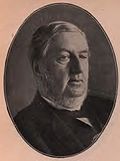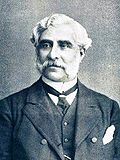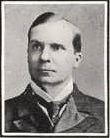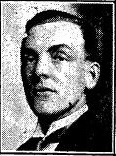Members of Parliament
1294–1640
1640–1950

| Derby | |
|---|---|
| Former borough constituency for the House of Commons | |
| 1295–1950 (split) | |
| Seats | two |
| Replaced by | Derby North and Derby South |
Derby is a former United Kingdom Parliamentary constituency. It was a constituency of the House of Commons of the Parliament of England, then of the Parliament of Great Britain from 1707 to 1800 and of the Parliament of the United Kingdom from 1801 to 1950. It was represented by two members of parliament. It was divided into the single-member constituencies of Derby North and Derby South in 1950.
Derby regularly sent two representatives to Parliament from Edward I's reign. In 1900 it was one of the first two constituencies to elect a member from the then newly formed Labour Party, along with Merthyr Tydfil.
In 1950 the constituency was abolished and replaced by the two single-member constituencies of Derby North and Derby South.
1885–1918: The existing parliamentary borough, and so much of the municipal borough of Derby as was not already included in the parliamentary borough. [1]

| Party | Candidate | Votes | % | ±% | |
|---|---|---|---|---|---|
| Whig | Henry Cavendish | Unopposed | |||
| Whig | Edward Strutt | Unopposed | |||
| Registered electors | c. 650 | ||||
| Whig hold | |||||
| Whig hold | |||||
| Party | Candidate | Votes | % | ±% | |
|---|---|---|---|---|---|
| Whig | Henry Cavendish | Unopposed | |||
| Whig | Edward Strutt | Unopposed | |||
| Registered electors | c. 650 | ||||
| Whig hold | |||||
| Whig hold | |||||
| Party | Candidate | Votes | % | ±% | |
|---|---|---|---|---|---|
| Whig | Edward Strutt | 884 | 43.5 | N/A | |
| Whig | Henry Cavendish | 716 | 35.3 | N/A | |
| Tory | Charles Henry Colvile | 430 | 21.2 | New | |
| Majority | 286 | 14.1 | N/A | ||
| Turnout | 1,136 | 82.1 | N/A | ||
| Registered electors | 1,384 | ||||
| Whig hold | Swing | N/A | |||
| Whig hold | Swing | N/A | |||
| Party | Candidate | Votes | % | ±% | |
|---|---|---|---|---|---|
| Whig | Edward Strutt | 903 | 42.0 | −1.5 | |
| Whig | John Ponsonby | 724 | 33.6 | −1.7 | |
| Conservative | Francis Curzon [29] | 525 | 24.4 | +3.2 | |
| Majority | 199 | 9.2 | −4.9 | ||
| Turnout | c. 1,076 | c. 72.8 | c. +9.3 | ||
| Registered electors | 1,478 | ||||
| Whig hold | Swing | −1.6 | |||
| Whig hold | Swing | −1.7 | |||
| Party | Candidate | Votes | % | ±% | |
|---|---|---|---|---|---|
| Whig | Edward Strutt | 836 | 32.1 | −9.9 | |
| Whig | John Ponsonby | 791 | 30.3 | −3.3 | |
| Conservative | Francis Curzon [29] | 525 | 20.1 | +7.9 | |
| Conservative | Charles Robert Colvile | 456 | 17.5 | +5.3 | |
| Majority | 266 | 10.2 | +1.0 | ||
| Turnout | 1,318 | 75.3 | c. +2.5 | ||
| Registered electors | 1,751 | ||||
| Whig hold | Swing | −8.3 | |||
| Whig hold | Swing | −5.0 | |||
| Party | Candidate | Votes | % | ±% | |
|---|---|---|---|---|---|
| Whig | Edward Strutt | 875 | 39.0 | +6.9 | |
| Whig | John Ponsonby | 784 | 34.9 | +4.6 | |
| Conservative | Edward Sacheverell Chandos Pole | 587 | 26.1 | −11.5 | |
| Majority | 197 | 8.8 | −1.4 | ||
| Turnout | 1,377 | 72.2 | −3.1 | ||
| Registered electors | 1,906 | ||||
| Whig hold | Swing | +6.3 | |||
| Whig hold | Swing | +5.2 | |||
Strutt was appointed Chief Commissioner of Railways, requiring a by-election.
| Party | Candidate | Votes | % | ±% | |
|---|---|---|---|---|---|
| Whig | Edward Strutt | 835 | 59.9 | −14.0 | |
| Conservative | Digby Mackworth | 559 | 40.1 | +14.0 | |
| Majority | 276 | 19.8 | +11.0 | ||
| Turnout | 1,394 | 68.9 | −3.3 | ||
| Registered electors | 2,022 | ||||
| Whig hold | Swing | −14.0 | |||
Ponsonby succeeded to the peerage, becoming 5th Earl of Bessborough, causing a by-election.
| Party | Candidate | Votes | % | ±% | |
|---|---|---|---|---|---|
| Whig | Frederick Leveson-Gower | Unopposed | |||
| Whig hold | |||||
| Party | Candidate | Votes | % | ±% | |
|---|---|---|---|---|---|
| Whig | Edward Strutt | 881 | 31.8 | −7.2 | |
| Whig | Frederick Leveson-Gower | 852 | 30.8 | −4.1 | |
| Conservative | Henry Raikes [30] | 820 | 29.6 | +3.5 | |
| Chartist | Philip McGrath [31] | 216 | 7.8 | New | |
| Majority | 32 | 1.2 | −7.6 | ||
| Turnout | 1,385 | 63.6 | −8.6 | ||
| Registered electors | 2,177 | ||||
| Whig hold | Swing | −4.5 | |||
| Whig hold | Swing | −2.9 | |||
The election was declared void on petition due to bribery and treating by Strutt's and Leveson-Gower's agents, and the writ suspended in March 1848, later causing a by-election. [32]
| Party | Candidate | Votes | % | ±% | |
|---|---|---|---|---|---|
| Radical | Michael Thomas Bass | 956 | 28.1 | −3.7 | |
| Radical | Lawrence Heyworth | 912 | 26.8 | −4.0 | |
| Conservative | James William Freshfield [33] | 778 | 22.8 | +8.0 | |
| Conservative | James Lord [34] | 760 | 22.3 | +7.5 | |
| Majority | 134 | 4.0 | N/A | ||
| Turnout | 1,703 (est) | 78.2 (est) | +14.6 | ||
| Registered electors | 2,177 | ||||
| Radical gain from Whig | Swing | −5.7 | |||
| Radical gain from Whig | Swing | −5.9 | |||
| Party | Candidate | Votes | % | ±% | |
|---|---|---|---|---|---|
| Radical | Michael Thomas Bass | 1,252 | 38.0 | +6.2 | |
| Conservative | Thomas Horsfall | 1,025 | 31.1 | +1.5 | |
| Radical | Lawrence Heyworth | 1,018 | 30.9 | +0.1 | |
| Turnout | 2,160 (est) | 88.2 (est) | +24.6 | ||
| Registered electors | 2,448 | ||||
| Majority | 227 | 6.9 | N/A | ||
| Radical gain from Whig | Swing | +2.7 | |||
| Majority | 7 | 0.2 | N/A | ||
| Conservative gain from Whig | Swing | −3.9 | |||
Horsfall's election was in March 1853 declared void due to bribery, and Heyworth was declared elected in his place. [35]
| Party | Candidate | Votes | % | ±% | |
|---|---|---|---|---|---|
| Radical | Michael Thomas Bass | 884 | 40.9 | +2.9 | |
| Radical | Samuel Beale | 846 | 39.2 | +8.3 | |
| Conservative | William Forbes Mackenzie | 430 | 19.9 | −11.2 | |
| Majority | 416 | 19.3 | +12.4 | ||
| Turnout | 1,295 (est) | 52.2 (est) | −36.0 | ||
| Registered electors | 2,479 | ||||
| Radical hold | Swing | +4.3 | |||
| Radical gain from Conservative | Swing | +7.0 | |||
| Party | Candidate | Votes | % | ±% | |
|---|---|---|---|---|---|
| Liberal | Michael Thomas Bass | 1,260 | 35.5 | −5.4 | |
| Liberal | Samuel Beale | 902 | 25.4 | −13.8 | |
| Liberal | William Milbourne James [36] [37] | 736 | 20.8 | N/A | |
| Conservative | Henry Cecil Raikes [38] | 648 | 18.3 | −1.6 | |
| Majority | 166 | 4.6 | −14.7 | ||
| Turnout | 1,773 (est) | 70.6 (est) | +18.4 | ||
| Registered electors | 2,513 | ||||
| Liberal hold | Swing | −2.3 | |||
| Liberal hold | Swing | −6.5 | |||
| Party | Candidate | Votes | % | ±% | |
|---|---|---|---|---|---|
| Conservative | William Thomas Cox | 1,096 | 31.7 | +13.4 | |
| Liberal | Michael Thomas Bass | 1,063 | 30.7 | +5.3 | |
| Liberal | Samuel Plimsoll | 691 | 20.0 | −0.8 | |
| Liberal | Samuel Beale | 608 | 17.6 | −7.8 | |
| Majority | 488 | 14.1 | N/A | ||
| Turnout | 2,277 (est) | 92.9 (est) | +22.3 | ||
| Registered electors | 2,450 | ||||
| Conservative gain from Liberal | Swing | +7.3 | |||
| Liberal hold | Swing | −4.1 | |||
| Party | Candidate | Votes | % | ±% | |
|---|---|---|---|---|---|
| Liberal | Michael Thomas Bass | 4,995 | 41.1 | +10.4 | |
| Liberal | Samuel Plimsoll | 4,677 | 38.4 | +18.4 | |
| Conservative | William Thomas Cox | 2,492 | 20.5 | −11.2 | |
| Majority | 2,185 | 17.9 | N/A | ||
| Turnout | 7,328 (est) | 75.0 (est) | −17.9 | ||
| Registered electors | 9,777 | ||||
| Liberal gain from Conservative | Swing | +8.0 | |||
| Liberal hold | Swing | +12.0 | |||
| Party | Candidate | Votes | % | ±% | |
|---|---|---|---|---|---|
| Liberal | Michael Thomas Bass | 5,579 | 39.4 | −1.7 | |
| Liberal | Samuel Plimsoll | 4,938 | 34.9 | −3.5 | |
| Conservative | William Thomas Cox [39] | 3,642 | 25.7 | +5.2 | |
| Majority | 1,296 | 9.2 | −8.7 | ||
| Turnout | 8,901 (est) | 78.7 (est) | +3.7 | ||
| Registered electors | 11,316 | ||||
| Liberal hold | Swing | −2.2 | |||
| Liberal hold | Swing | −3.1 | |||
| Party | Candidate | Votes | % | ±% | |
|---|---|---|---|---|---|
| Liberal | Michael Thomas Bass | 8,864 | 45.8 | +6.4 | |
| Liberal | Samuel Plimsoll | 7,758 | 40.1 | +5.2 | |
| Conservative | Thomas Collins | 2,730 | 14.1 | −11.6 | |
| Majority | 5,028 | 26.0 | +16.8 | ||
| Turnout | 11,594 (est) | 89.1 (est) | +10.4 | ||
| Registered electors | 13,006 | ||||
| Liberal hold | Swing | +6.1 | |||
| Liberal hold | Swing | +5.5 | |||
Plimsoll's resignation caused a by-election.
| Party | Candidate | Votes | % | ±% | |
|---|---|---|---|---|---|
| Liberal | William Harcourt | Unopposed | |||
| Liberal hold | |||||
Bass' resignation caused a by-election.
| Party | Candidate | Votes | % | ±% | |
|---|---|---|---|---|---|
| Liberal | Thomas Roe | Unopposed | |||
| Liberal hold | |||||

| Party | Candidate | Votes | % | ±% | |
|---|---|---|---|---|---|
| Liberal | Thomas Roe | 7,813 | 36.1 | −9.7 | |
| Liberal | William Harcourt | 7,630 | 35.3 | −4.8 | |
| Conservative | William Brown Hextall | 4,943 | 22.8 | +8.7 | |
| Independent Liberal | Alfred Stace Dyer [43] | 1,251 | 5.8 | New | |
| Majority | 2,687 | 12.5 | −13.5 | ||
| Turnout | 12,868 | 86.2 | −2.9 (est) | ||
| Registered electors | 14,925 | ||||
| Liberal hold | Swing | −9.2 | |||
| Liberal hold | Swing | −6.8 | |||
Harcourt's appointment as Chancellor of the Exchequer caused a by-election.
| Party | Candidate | Votes | % | ±% | |
|---|---|---|---|---|---|
| Liberal | William Harcourt | Unopposed | |||
| Liberal hold | |||||

| Party | Candidate | Votes | % | ±% | |
|---|---|---|---|---|---|
| Liberal | Thomas Roe | 6,571 | 37.8 | +1.7 | |
| Liberal | William Harcourt | 6,431 | 37.1 | +1.8 | |
| Liberal Unionist | William Evans [44] | 4,346 | 25.1 | +2.3 | |
| Majority | 2,085 | 12.0 | −0.5 | ||
| Turnout | 10,758 | 72.1 | −14.1 | ||
| Registered electors | 14,925 | ||||
| Liberal hold | Swing | +0.3 | |||
| Liberal hold | Swing | +0.3 | |||

| Party | Candidate | Votes | % | ±% | |
|---|---|---|---|---|---|
| Liberal | William Harcourt | 7,507 | 29.1 | −8.7 | |
| Liberal | Thomas Roe | 7,389 | 28.6 | −8.5 | |
| Conservative | William Brown Hextall | 5,546 | 21.5 | New | |
| Liberal Unionist | Alfred Seale Haslam | 5,363 | 20.8 | −4.3 | |
| Majority | 1,843 | 7.1 | −4.9 | ||
| Turnout | 12,903 [est 1] | 83.6 | +11.5 | ||
| Registered electors | 15,754 | ||||
| Liberal hold | Swing | −2.2 | |||
| Liberal hold | Swing | −2.1 | |||
Harcourt's appointment as Chancellor of the Exchequer requires a by-election.
| Party | Candidate | Votes | % | ±% | |
|---|---|---|---|---|---|
| Liberal | William Harcourt | 6,508 | 80.1 | +22.4 | |
| Independent | Henry Farmer-Atkinson [n 1] | 1,619 | 19.9 | New | |
| Majority | 4,889 | 60.2 | +53.1 | ||
| Turnout | 8,127 | 51.6 | −32.0 | ||
| Registered electors | 15,754 | ||||
| Liberal hold | Swing | ||||


| Party | Candidate | Votes | % | ±% | |
|---|---|---|---|---|---|
| Conservative | Henry Howe Bemrose | 7,907 | 28.0 | +6.5 | |
| Conservative | Geoffrey Drage | 7,076 | 25.1 | +4.3 | |
| Liberal | William Harcourt | 6,785 | 24.0 | −5.1 | |
| Liberal | Thomas Roe | 6,475 | 22.9 | −5.7 | |
| Majority | 291 | 1.1 | N/A | ||
| Turnout | 14,122 [est 1] | 82.8 | −0.8 | ||
| Registered electors | 17,379 | ||||
| Conservative gain from Liberal | Swing | +5.8 | |||
| Conservative gain from Liberal | Swing | +4.7 | |||

| Party | Candidate | Votes | % | ±% | |
|---|---|---|---|---|---|
| Liberal | Thomas Roe | 7,922 | 26.6 | −20.3'"`UNIQ−−ref−00000119−QINU`"' | |
| Labour Repr. Cmte. | Richard Bell | 7,640 | 25.7 | New | |
| Conservative | Henry Howe Bemrose | 7,397 | 24.9 | −3.1 | |
| Conservative | Geoffrey Drage | 6,775 | 22.8 | −2.3 | |
| Turnout | 29,734 | 84.5 | +1.7 | ||
| Registered electors | 18,270 | ||||
| Majority | 525 | 1.7 | N/A | ||
| Liberal gain from Conservative | Swing | ||||
| Majority | 865 | 3.8 | N/A | ||
| Labour Repr. Cmte. gain from Conservative | Swing | ||||
| Party | Candidate | Votes | % | ±% | |
|---|---|---|---|---|---|
| Lib-Lab | Richard Bell | 10,361 | 31.0 | +5.3 | |
| Liberal | Thomas Roe | 10,239 | 30.6 | +4.0 | |
| Conservative | James Henry Edward Holford | 6,421 | 19.2 | −5.7 | |
| Conservative | Edward George Spencer Churchill | 6,409 | 19.2 | −3.6 | |
| Turnout | 33,430 | 87.6 | +3.1 | ||
| Registered electors | 19,543 | ||||
| Majority | 3,818 | 11.4 | +9.7 | ||
| Lib-Lab hold | Swing | +5.5 | |||
| Liberal hold | Swing | +4.9 | |||
| Party | Candidate | Votes | % | ±% | |
|---|---|---|---|---|---|
| Liberal | Thomas Roe | 10,343 | 28.3 | −2.3 | |
| Labour | J. H. Thomas [n 2] | 10,189 | 27.9 | −3.1 | |
| Conservative | Arthur Edward Beck | 8,038 | 22.0 | +2.8 | |
| Conservative | Arthur Page | 7,953 | 21.8 | +2.6 | |
| Turnout | 36,523 | 92.5 | +4.9 | ||
| Registered electors | 20,113 | ||||
| Majority | 2,305 | 6.3 | −5.1 | ||
| Liberal hold | Swing | −2.6 | |||
| Majority | 2,151 | 5.9 | N/A | ||
| Labour gain from Lib-Lab | Swing | ||||
| Party | Candidate | Votes | % | ±% | |
|---|---|---|---|---|---|
| Liberal | Thomas Roe | 9,515 | 35.5 | +7.2 | |
| Labour | J. H. Thomas | 9,144 | 34.1 | +6.2 | |
| Conservative | Arthur Edward Beck [n 3] | 8,160 | 30.4 | −13.4 | |
| Turnout | 26,819 | 88.0 | −4.5 | ||
| Registered electors | 20,113 | ||||
| Majority | 1,355 | 5.1 | −1.2 | ||
| Liberal hold | Swing | +10.3 | |||
| Majority | 984 | 3.7 | −2.2 | ||
| Labour hold | Swing | +9.8 | |||

General Election 1914–15:
Another General Election was required to take place before the end of 1915. The political parties had been making preparations for an election to take place and by July 1914, the following candidates had been selected;

| Party | Candidate | Votes | % | ±% | |
|---|---|---|---|---|---|
| Liberal | William Collins | Unopposed | |||
| Liberal hold | |||||
| Party | Candidate | Votes | % | ±% | |
|---|---|---|---|---|---|
| Labour | J. H. Thomas | 25,145 | 37.8 | +3.7 | |
| Unionist | Albert Green | 14,920 | 22.4 | −8.0 | |
| Liberal | William Blews Rowbotham | 13,408 | 20.2 | −15.3 | |
| National Democratic | Harold Machin Smith | 13,012 | 19.6 | New | |
| Turnout | 66,485 | 65.5 | −22.5 | ||
| Majority | 1,512 | 2.2 | N/A | ||
| Unionist gain from Liberal | Swing | ||||
| Majority | 11,737 | 17.6 | +13.9 | ||
| Labour hold | Swing | ||||

| Party | Candidate | Votes | % | ±% | |
|---|---|---|---|---|---|
| Labour | 25,215 | 27.0 | −10.8 | ||
| Liberal | 24,068 | 25.8 | +5.6 | ||
| Unionist | Albert Green | 22,240 | 23.9 | +1.5 | |
| Labour | William Raynes | 21,677 | 23.3 | N/A | |
| Turnout | 93,200 | 84.0 | +18.5 | ||
| Majority | 1,828 | 1.9 | N/A | ||
| Liberal gain from Unionist | Swing | ||||
| Majority | 2,975 | 3.1 | −14.5 | ||
| Labour hold | Swing | ||||
| Party | Candidate | Votes | % | ±% | |
|---|---|---|---|---|---|
| Labour | 24,887 | 29.0 | +2.0 | ||
| Labour | 20,318 | 23.7 | +0.4 | ||
| Unionist | Henry Fitz-Herbert Wright | 20,070 | 23.4 | −0.5 | |
| Liberal | Charles Henry Roberts | 10,669 | 12.5 | −13.3 | |
| Ind. Unionist | Thomas Clifford Newbold | 9,772 | 11.4 | New | |
| Turnout | 85,716 | 81.1 | −2.9 | ||
| Majority | 9,649 | 11.2 | N/A | ||
| Labour gain from Liberal | Swing | +6.8 | |||

| Party | Candidate | Votes | % | ±% | |
|---|---|---|---|---|---|
| Labour | 27,423 | 25.7 | −3.3 | ||
| Unionist | 25,425 | 23.8 | +0.4 | ||
| Labour | William Robert Raynes | 25,172 | 23.6 | −0.1 | |
| Unionist | Hilda Hulse | 21,700 | 20.3 | N/A | |
| Liberal | James Henderson-Stewart | 7,083 | 6.6 | −5.9 | |
| Turnout | 99,720 | 85.2 | +4.1 | ||
| Majority | 5,723 | 5.4 | +5.1 | ||
| Labour hold | Swing | ||||
| Majority | 353 | 0.2 | N/A | ||
| Unionist gain from Labour | Swing | ||||
| Party | Candidate | Votes | % | ±% | |
|---|---|---|---|---|---|
| Labour | 39,688 | 30.0 | +4.3 | ||
| Labour | 36,237 | 27.4 | +3.8 | ||
| Unionist | Richard Luce | 24,553 | 18.6 | −5.2 | |
| Unionist | John Arthur Aiton | 20,443 | 15.4 | −4.9 | |
| Liberal | L. du Garde Peach | 11,317 | 8.6 | +2.0 | |
| Turnout | 132,238 | 82.6 | −2.6 | ||
| Majority | 11,684 | 8.8 | N/A | ||
| Labour gain from Unionist | Swing | +4.5 | |||
| Labour hold | Swing | ||||
| Party | Candidate | Votes | % | ±% | |
|---|---|---|---|---|---|
| National Labour | 49,257 | 36.4 | N/A | ||
| Conservative | 47,729 | 34.3 | +0.3 | ||
| Labour | William Robert Raynes | 21,841 | 15.7 | −11.7 | |
| Labour | Walter Halls | 20,241 | 14.6 | −12.8 | |
| Majority | 27,416 | 19.7 | +10.9 | ||
| Turnout | 139,068 | 84.5 | +1.9 | ||
| National Labour hold | Swing | ||||
| Conservative gain from Labour | Swing | ||||
| Party | Candidate | Votes | % | ±% | |
|---|---|---|---|---|---|
| Conservative | 37,707 | 30.19 | |||
| National Labour | 37,566 | 30.08 | |||
| Labour | Herbert Arthur Hind | 25,037 | 20.04 | ||
| Labour | Leonard John Barnes | 24,594 | 19.69 | ||
| Majority | 12,670 | 10.15 | |||
| Turnout | 124,904 | ||||
| Conservative hold | Swing | ||||
| National Labour hold | Swing | ||||

| Party | Candidate | Votes | % | ±% | |
|---|---|---|---|---|---|
| Labour | Philip Noel-Baker | 28,419 | 52.5 | +12.8 | |
| National Labour | Archibald Church | 25,666 | 47.5 | +17.4 | |
| Majority | 2,753 | 5.0 | N/A | ||
| Turnout | 54,085 | 65.5 | |||
| Labour gain from National Labour | Swing | ||||
General Election 1939–40:
Another General Election was required to take place before the end of 1940. The political parties had been making preparations for an election to take place in Autumn 1939 and by then, the following candidates had been selected;
| Party | Candidate | Votes | % | ±% | |
|---|---|---|---|---|---|
| Labour | 42,196 | 33.60 | |||
| Labour | 40,800 | 32.49 | |||
| Conservative | Francis Lochrane | 21,460 | 17.09 | ||
| Conservative | Max Bemrose | 21,125 | 16.82 | ||
| Majority | 19,340 | 16.51 | N/A | ||
| Turnout | 125,581 | 76.39 | |||
| Labour gain from Conservative | Swing | ||||
| Labour hold | Swing | ||||
Notes
References